There are so many kinds of noodles in Vietnam. It may be a challenge for foreign people to distinguish them because all of them are called noodle or rice noodle in English.
In the scope of this writing, I’ll focus on the difference between some kinds of Vietnamese noodles with hope to help Vietnamese-food-lovers escape from confusion.
First of all, it’s definitely Pho or called Phở in Vietnamese.
The main ingredient of Pho is “banh pho” which is usually called just “pho” by Vietnamese people. It also applies for hu tiu. Vietnamese people tend to name a dish after its main ingredient. So we have “Pho” as a dish and also the main ingredient.
“Banh pho” is a kind of noodle that has linguine shape (it looks like linguine but in white not in green or yellow)
Sometimes, you may see words “Pho bo” (Phở bò) in some banners or standee. Don’t get confused. “Phở bò” and “pho” actually are the same thing. People just like to add a word. And as many people may know “bo” in “Pho bo” means “beef.”
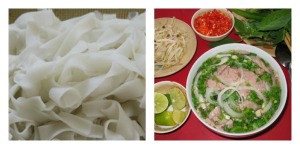
And we have hu tiu (hủ tíu) or hủ tiếu. Hu tiu is a common dish in the South of Vietnam, particularly in HCM city and the Mekong Delta.

Like Pho, “hiu tiu” is the name of a dish and also the main ingredient of that dish. We can call the main ingredient “banh hu tiu” but not many people do it, so just call “hu tiu”
Hu tiu (I mean “banh hu tiu”) is another kind of noodle which is white like “banh pho” but in a smaller shape in wide.
Both of them are called rice noodle in English which causes confusion. They even seem look similar from the outside. Although they are all white, “Pho” is a little bit paler. Like snow white vs decorator white. Pho is also wetter than hu tiu. More than that, when tasting you may realize the former is chewier than latter. Not to mention the process of making these kind of rice noodles is difference.
There are many versions of hu tiu such as hu tiu My Tho, hu tiu Sa Dec, hu tiu Nam Vang. My Tho, Sa Dec are places well-known for both making “banh hu tiu” and serving hu tiu as delicacy. Hu Tiu made in Sadec is unique for its chewiness. Of course, it is not like chewing gum (!). It tastes amazing.
You may catch “hu tiu Nam Vang” in many banners in HCM city and think it’s difference from common “hu tiu”. No, it’s not. Nam Vang actually means Phomphenh– the capital of Cambodia- where the real origin of hu tiu is derived. Again, people tend to add something with hope it looks a little bit more special comparing others. The fact is, not many Vietnamese people care about the origin of hu tiu, and they even don’t know what Nam Vang means. It’s understandable cause it’s a norm to them.
There is no official recipe of cooking hu tiu. It depends on the preference, the tradition, the eating habit of regions.
Hu tiu can be served in two ways, one with broth like soup and the other is without which called “hu tiu kho” (hủ tíu khô), but usually, a bowl of soup are brought along with the main dish as a side dish.
We also have “bánh canh” and “nui.” Often, in the Mekong Delta, if a restaurant or an eatery serves hu tiu, they also serve “bánh canh”, “nui” and even “miến” because they can share the same broth or soup.
“Banh canh” is a kind of thick noodle made from tapioca flour and rice. They have shape like Japanese Udon noddle but usually in white.
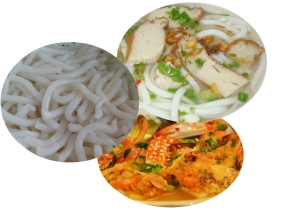
Banh canh can be served with many other different ingredients from pork to crap to scrimp to fish sausage (chả cá)
Nui is another kind of thick noodle. “Nui” is actually a word originate from “nouille” in French. In other word, nui is Vietnamese pasta. Like pasta, “nui” is diverse in term of shape. Short tubes like ditalini, curly like fusilli, ribbon like farfelle or even in heart and star form. Nui can be served with broth like hu tiu or banh canh or served with sause like Italian pasta. Besides, in HCM city, it can be “nui chien trung” which means “nui with fried egg.” “Nui with fried egg” is one of the most popular street food in HCM city.
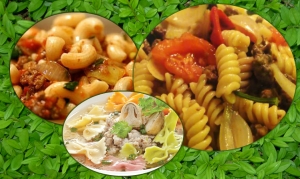
Bún or rice vermicelli in English. Bún has two types of shape, one is thin long and another is a little bit thicker but not thick as Udon noodle- which is more popular in the South of Vietnam. Some other Asian countries have their own rice vermicelli but the difference is their vermicelli usually in dry form, the Vietnamese one is wet.
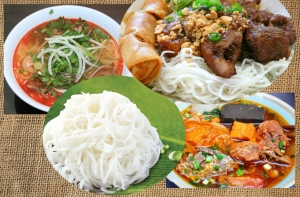
And we have “mì”. There are many shapes of “mì” but all of them are in yellow. It may has shape like pho or bun but if it’s in yellow, it is “mi”.
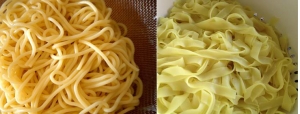
Some people may be bewildered between mì and “banh mi” (bánh mì). They are far different. “Mì” in “mi” and “mi” in “bánh mì” refer to “floura”- the key ingredient to make them. But Mi is noodle and Banh mi is bread. I’m not sure but it seems that there is a connection between “bánh” in Vietnamese and “pain” in French.
So many things to remember!
I have another way to distinguish them. I know it’s a “everybody knows” tip but I have to say that is tasting. The shape may make you get tangled but I believe the taste not.
source of photos: google











